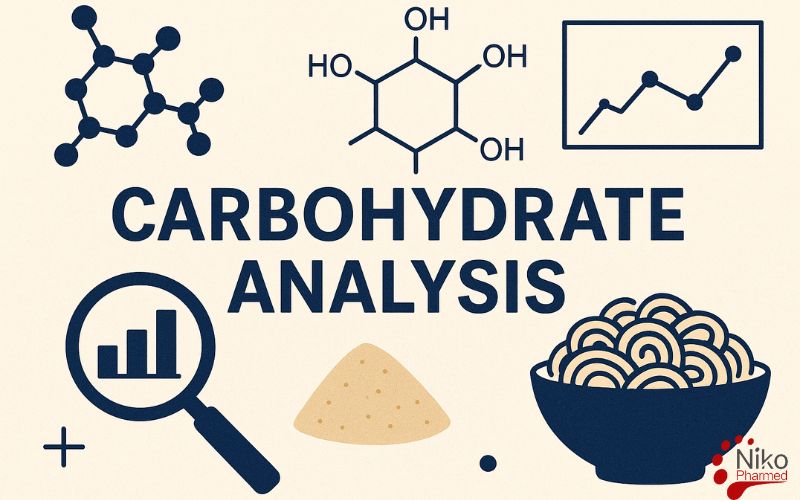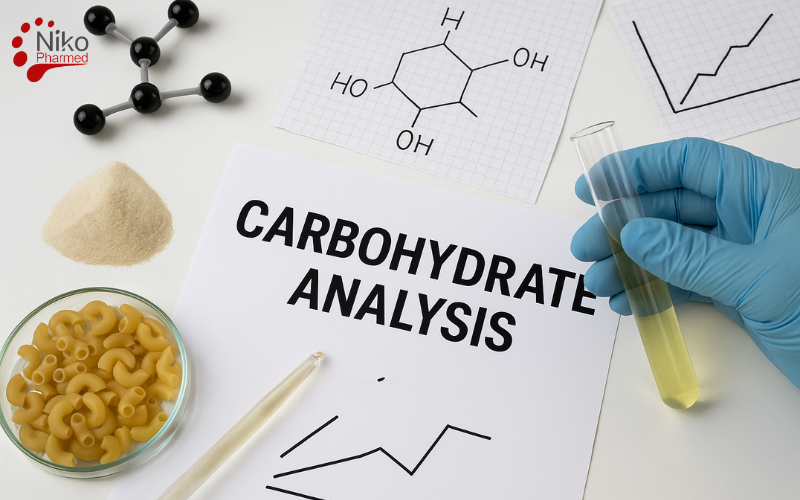What is Carbohydrate Analysis?
Carbohydrate Analysis, refers to the analytical determination of the composition of individual neutral monosaccharides specifically arabinose, galactose, glucose, mannose, and xylose in a sample, typically expressed in milligrams per gram of dry matter.
Carbohydrate Analysis Procedures
ISO Standards
ISO 21437:2020 – Pulps – Determination of Carbohydrate Composition
Sample Preparation & Hydrolysis: The method commences with the acid hydrolysis of polysaccharides using sulfuric acid to liberate monosaccharides from wood pulp matrices.
Chromatographic Determination: The released monosaccharides namely arabinose, galactose, glucose, xylose, and mannose—are quantified via chromatographic techniques such as High‑Performance Anion‑Exchange Chromatography with Pulsed Amperometric Detection (HPAE‑PAD) (i.e., ion chromatography, IC) or Gas Chromatography with Flame Ionization Detection (GC‑FID). This enables sensitive determination down to approximately 1 mg per gram of oven-dried pulp.
ISO 11292:1995 – Instant Coffee – Determination of Free and Total Carbohydrates
Two distinct procedural pathways are defined:
Method A (Free Carbohydrates)
Direct dissolution of the sample in water and subsequent chromatography to quantify monosaccharides (arabinose, fructose, galactose, glucose, mannose), as well as sucrose and mannitol, expressed as mass percent (dry basis).
Method B (Total Carbohydrates)
Incorporates a strong hydrolysis step, allowing quantification of monosaccharides including xylose and mannitol—also expressed on a dry-mass basis.
USP Standards
While USP does not publish a single unifying “carbohydrate analysis” monograph, relevant methods are embedded within USP-NF monographs for individual carbohydrates, as well as general analytical chapters.
Ion Chromatography (IC) with USP‑designated Columns
Carbohydrate analysis as performed in pharmaceutical and related contexts typically employs ion chromatography, leveraging USP‑specified resin-packed columns—such as types L17, L19, L22, L34, and L58. These media support the separation and quantification of various carbohydrates, with compatibility across agencies like FAO, FCC, and EP.
Column Selection Guided by USP Media Standards
Vendors (e.g., Agilent) provide column ranges (e.g., Hi‑Plex family) matched to USP media types:
Hi‑Plex Ca aligns with media type L19 and is suited for sugars and sugar alcohols, under isocratic conditions using water and with detection via refractive index (RI).
These columns deliver robust performance improved resolution, reproducibility, and reduced solvent usage—accordant with USP definitions of the media.
Liquid Chromatography
Techniques such as cation-exchange chromatography with RI detection or high‑performance anion‑exchange chromatography (HPAE) are employed in food/feed matrices to separate and detect monosaccharides (e.g., glucose, galactose, fructose).
HPAE‑PAD (High‑Performance Anion‑Exchange Chromatography with Pulsed Amperometric Detection)
Widely adopted for its capacity to separate and detect a broad spectrum of carbohydrates including mono and oligosaccharides, sugar acids, alcohols, and phosphorylated sugars down to sub‑picomole sensitivity without chemical derivatization.
Other Chromatographic Options with MS Detection:
Comparative studies show that for monosaccharide profiling, Reversed‑Phase LC–MS (RP‑LC–MS) after derivatization (e.g., with PMP) offers superior separation, sensitivity, and repeatability compared to HILIC, GC, or SFC when coupled to MS detection.
Concise Summary of ISO vs. USP Carbohydrate Analysis Procedures
| Aspect | ISO (21437 / 11292) | USP / Industry |
|---|---|---|
| Sample Prep & Scope | Sulfuric-acid hydrolysis to release monosaccharides | Varies by monograph; may include direct or hydrolyzed analysis |
| Chromatography | HPAE-PAD or GC-FID (ISO 21437); HPAE-PAD-based HPLC (ISO 11292) | IC using USP-specified resin types (L17, L19, etc.), HPAE-PAD, RP-LC–MS with derivatization |
| Detection Modes | Pulsed amperometric, flame ionization | RI, PAD, UV, MS depending on technique and matrix |
| Quantitative Scope | Neutral monosaccharide composition; free vs. total carbohydrates | Monosaccharides, sugar alcohols, and more depending on method |
Formal Scientific Description
The procedure for carbohydrate analysis under ISO and USP frameworks systematically encompasses:
(i) Sample preparation, which in ISO methods commonly involves acid hydrolysis (e.g., sulfuric acid) to break down polysaccharides into monosaccharides, particularly in pulp or food matrices;
(ii) Separation, achieved via HPAE-PAD (ion chromatography) or GC-FID under ISO-21437 for pulp, or HPAE-based high-performance anion-exchange chromatography for instant coffee (ISO-11292), distinguishing free versus total carbohydrates;
(iii) Quantification, employing detectors such as pulsed amperometric detection (PAD), refractive index (RI), flame ionization (FID), or mass spectrometry contingent on the method;
in USP practices, carbohydrate quantification is conducted using ion-exchange chromatographic columns conforming to USP resin types (L17, L19, etc.), with detection via RI, PAD, UV, or LC-MS (particularly RP-LC–MS with derivatization) to achieve accurate identification and quantification relevant to pharmaceutical and food applications.
Nikopharmed Carbohydrate Analysis Laboratory
Laboratory Accreditation and Global Recognition
At Nikopharmad, our Carbohydrate Analysis services are backed by ISO/IEC 17025 certification and ILAC accreditation, ensuring strict adherence to globally recognized analytical quality and technical competence standards. These credentials guarantee that our carbohydrate determinations meet the most rigorous international regulatory requirements and are recognized by AOAC International, ISO standards, USP, Ph. Eur., and leading food, beverage, pharmaceutical, and nutritional supplement regulatory authorities worldwide.
Technical Excellence and Validated Infrastructure
Our state-of-the-art analytical facility is equipped with:
- High-Performance Anion-Exchange Chromatography with Pulsed Amperometric Detection (HPAE-PAD) for precise monosaccharide and oligosaccharide profiling
- Ion Chromatography (IC) with USP-specified stationary phases for regulatory-compliant sugar quantification
- High-Performance Liquid Chromatography (HPLC) with refractive index (RI) and diode-array detection for general carbohydrate separation
- LC–MS/MS platforms for ultra-trace analysis and structural elucidation
- Validated hydrolysis and derivatization apparatus for total carbohydrate and specific sugar class determinations
We are capable of analyzing carbohydrates in a wide range of matrices—from functional foods, beverages, dairy, and cereals to dietary supplements, pharmaceuticals, and fermentation products. Also Our carbohydrate analysis typically includes the determination of total sugar content alongside other key carbohydrates.
Regulatory-Ready Reporting and Timely Results
In industries where compliance timelines are critical, Nikopharmad delivers rapid, accurate, and defensible carbohydrate analysis results. All analytical reports include:
- Full method validation records
- Traceable calibration data
- Statistical analysis aligned with FDA, Codex Alimentarius, European Commission, and other international regulatory submission requirements
Our optimized workflow ensures fast turnaround times without compromising analytical precision or compliance—supporting quality assurance programs, product certification, import/export inspections, nutritional labeling, and label claim verification.
Confidentiality and Data Integrity
We uphold the highest levels of client confidentiality and data security. All carbohydrate testing activities are carried out under strict non-disclosure agreements and supported by 21 CFR Part 11-compliant electronic data systems. Every analysis is documented with a complete audit trail, ensuring traceability, reliability, and integrity of results. Proprietary formulations, research data, and regulatory submissions are handled with uncompromising ethical and professional standards.
Competitive Pricing with Uncompromised Quality
We offer cost-effective carbohydrate analysis solutions tailored to the needs of small enterprises, global corporations, and regulatory agencies. Our transparent pricing structure allows clients to meet compliance requirements efficiently while upholding international analytical standards, reducing approval timelines without compromising the quality or reliability of results.
To request testing or a complimentary consultation contact Nikopharmad
Partner with Nikopharmad for Expert Carbohydrate Analysis
By partnering with Nikopharmad, you gain access to a globally accredited laboratory dedicated to scientific excellence, regulatory compliance, and data confidentiality. Whether ensuring product consistency, verifying label claims, meeting market-entry regulations, or satisfying strict industry standards, our carbohydrate analysis expertise guarantees accurate, reliable, and internationally recognized results, helping you achieve compliance faster and with complete confidence.


